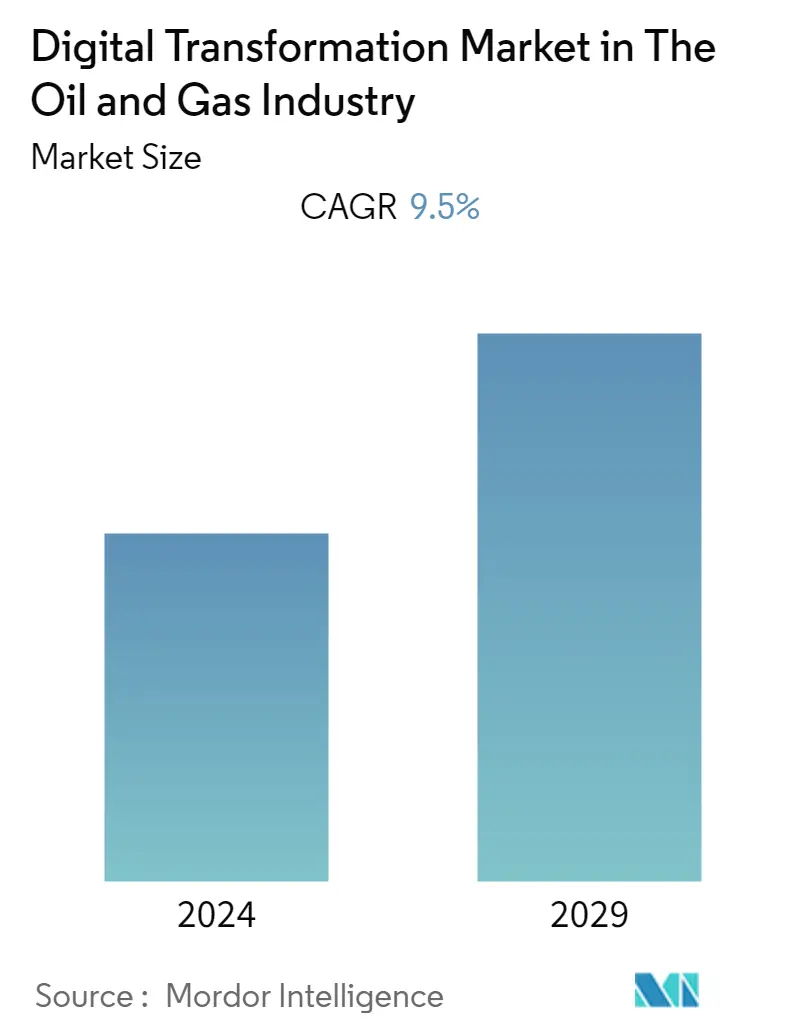Market Size of Digital Transformation Industry in The Oil and Gas Industry

| Study Period | 2019 - 2029 |
| Base Year For Estimation | 2023 |
| CAGR | 9.50 % |
| Fastest Growing Market | North America |
| Largest Market | Asia Pacific |
| Market Concentration | Medium |
Major Players
*Disclaimer: Major Players sorted in no particular order |
Need a report that reflects how COVID-19 has impacted this market and its growth?
Digital Transformation in Oil & Gas Market Analysis
- The digital transformation market in the oil and gas industry is expected to register a CAGR of 9.5% during the forecast period. Digital transformation has been one of the key trends driving the global oil and gas industry since the last decade. This transformation enables the operations to leverage advanced digital technologies such as AI, IoT, and Big Data, among others, to drive efficiencies and thereby open up new opportunities for the same, as it might involve digital twins, which evidently improves the efficiency of predictive maintenance of the critical assets and thereby restricting the exposure of hazardous task to the workers in the facilities.
- Extended reality is the latest and emerging solution in the oil and gas industry. Companies such as Shell, ExxonMobil, and BP are among the first players to adopt immersive technologies in the field.
- The offshore oil and gas business uses AI in data science to make the complex data used for oil and gas exploration and production more reachable, which lets companies discover new exploration prospects or make more use of existing infrastructures. For instance, recently, BP invested in Houston-based start-up Belmont Technology to strengthen the company's AI capabilities and develop a cloud-based geoscience platform nicknamed "Sandy."
- Among all the enabling technologies, artificial intelligence is poised to play a significant role over the forecast period. AI is also used to increase the safety of gas stations for preventive maintenance. However, there have been growing incidences of fires at gas stations. For instance, a gas station in Mccarran Airport in Las Vegas had an accidental fire in September 2021. Such events may prove deadly and destroy gas stations and the surrounding area. However, intelligent cameras based on AI can access the risk area and lessen the extent of potential damage.
- In November 2021, ElectrifAi announced the availability of Computer Vision (CV) and Machine Learning as a Service (MLaaS) for the oil, gas, and energy industries at ADIPEC in Abu Dhabi. With ElectrifAi's MLaaS, companies need little to no experience to realize the maximum business and operational benefits of AI and ML. MLaaS deploys quickly within any cloud environment or on the customer premise.
- Additionally, adopting monitor equipment such as IoT will allow companies to further digitize the industry by automating and optimizing the processes and eliminating the risk associated, including safety and regulation issues, and remote access, by constantly monitoring the equipment.
- Furthermore, the oil prices declining drastically over 2020, in the wake of COVID-19, and a price war between Saudi Arabia and Russia, are acting as major restraints for oil-producing companies to deploy automation. In addition, according to the International Energy Agency (IEA), Texas-based Occidental Petroleum Corporation (Oxy) has made the most significant reduction in its capital expenditures for 2020 out of all global oil and gas producers in the world. COVID-19 has caused Oxy to reduce its 2020 capex by 48.1%, down to USD 2.7 billion from the USD 5.2 billion planned at the beginning of the year. However, the pandemic significantly highlighted the need for digitalization in the oil and gas industry. As such, companies started to plan investments in such transformations; hence, the market is expected to grow over the forecast period.
Digital Transformation in Oil & Gas Industry Segmentation
Digital transformation refers to leveraging emerging and prevalent digital technologies to realize tangible, game-changing benefits in any field of application. Given the dynamic nature of the oil and gas industry, it has now become imperative for companies to increasingly rely on technology to attain tangle benefits across various processes. The studied report is segmented by enabling technologies such as Big Data/Analytics and Cloud Computing, Internet of Things (IoT), Artificial Intelligence, Industrial Control Systems, Extended Reality, and Field Devices among different oil and gas industry activities such as upstream, midstream, downstream in multiple geographies. The market sizes and forecasts are provided in terms of value (USD million) for all the above segments.
| By Enabling Technologies | |
| Big Data/Analytics and Cloud Computing | |
| Internet of Things (IoT) | |
| Artificial Intelligence | |
| Industrial Control Systems (PLC, SCADA, HMI, DCS etc.) | |
| Extended Reality (AR, VR and MR) | |
| Field Devices (Sensors, Motors, VFD etc.) |
| By Oil and Gas Industry Activity | |
| Upstream | |
| Mid Stream | |
| Downstream |
| By Geography | ||||||
| ||||||
| ||||||
| ||||||
| ||||||
|
Digital Transformation Market in The Oil and Gas Industry Size Summary
The digital transformation market in the oil and gas industry is on a growth trajectory, driven by the adoption of advanced digital technologies such as AI, IoT, and Big Data. These technologies are being used to enhance operational efficiencies and open up new opportunities in the sector. The utilization of digital twins is one such example, which significantly improves the efficiency of predictive maintenance of critical assets and reduces the exposure of workers to hazardous tasks. Furthermore, extended reality is emerging as a promising solution in the industry, with major players like Shell, ExxonMobil, and BP being early adopters of this immersive technology. The market is also witnessing a rising trend of AI usage in the offshore oil and gas business. AI is being employed in data science to make complex data used for oil and gas exploration and production more accessible. This allows companies to discover new exploration prospects or make better use of existing infrastructures. AI is also being used to increase the safety of gas stations for preventive maintenance. Other enabling technologies like IoT are being adopted to further digitize the industry by automating and optimizing processes, eliminating associated risks, and enabling remote access by constantly monitoring equipment.
Explore MoreDigital Transformation Market in The Oil and Gas Industry Market Size - Table of Contents
-
1. MARKET DYNAMICS
-
1.1 Market Drivers
-
1.1.1 Increasing Need to Implement Disruptive Technologies to Optimize Operations & Increase Safety
-
1.1.2 Regulatory Requirements
-
-
1.2 Market Challenges
-
1.2.1 Volatile Oil Price Situation
-
1.2.2 Stagnant Industrial Growth in Developed Countries
-
-
-
2. MARKET SEGMENTATION
-
2.1 By Enabling Technologies
-
2.1.1 Big Data/Analytics and Cloud Computing
-
2.1.2 Internet of Things (IoT)
-
2.1.3 Artificial Intelligence
-
2.1.4 Industrial Control Systems (PLC, SCADA, HMI, DCS etc.)
-
2.1.5 Extended Reality (AR, VR and MR)
-
2.1.6 Field Devices (Sensors, Motors, VFD etc.)
-
-
2.2 By Oil and Gas Industry Activity
-
2.2.1 Upstream
-
2.2.2 Mid Stream
-
2.2.3 Downstream
-
-
2.3 By Geography
-
2.3.1 North America
-
2.3.1.1 United States
-
2.3.1.2 Canada
-
-
2.3.2 Europe
-
2.3.2.1 Germany
-
2.3.2.2 United Kingdom
-
2.3.2.3 France
-
2.3.2.4 Rest of Europe
-
-
2.3.3 Asia-Pacific
-
2.3.3.1 China
-
2.3.3.2 Japan
-
2.3.3.3 India
-
2.3.3.4 Rest of the Asia-Pacific
-
-
2.3.4 Latin America
-
2.3.4.1 Brazil
-
2.3.4.2 Argentina
-
2.3.4.3 Rest of Latin America
-
-
2.3.5 Middle East and Africa
-
2.3.5.1 United Arab Emirates
-
2.3.5.2 Saudi Arabia
-
2.3.5.3 Rest of Middle East and Africa
-
-
-
Digital Transformation Market in The Oil and Gas Industry Market Size FAQs
What is the current Digital Transformation Market in The Oil and Gas Industry size?
The Digital Transformation Market in The Oil and Gas Industry is projected to register a CAGR of 9.5% during the forecast period (2024-2029)
Who are the key players in Digital Transformation Market in The Oil and Gas Industry?
Schneider Electric SE, Rockwell Automation Inc. , Honeywell International Inc., Siemens AG and IBM Corporation are the major companies operating in the Digital Transformation Market in The Oil and Gas Industry.
